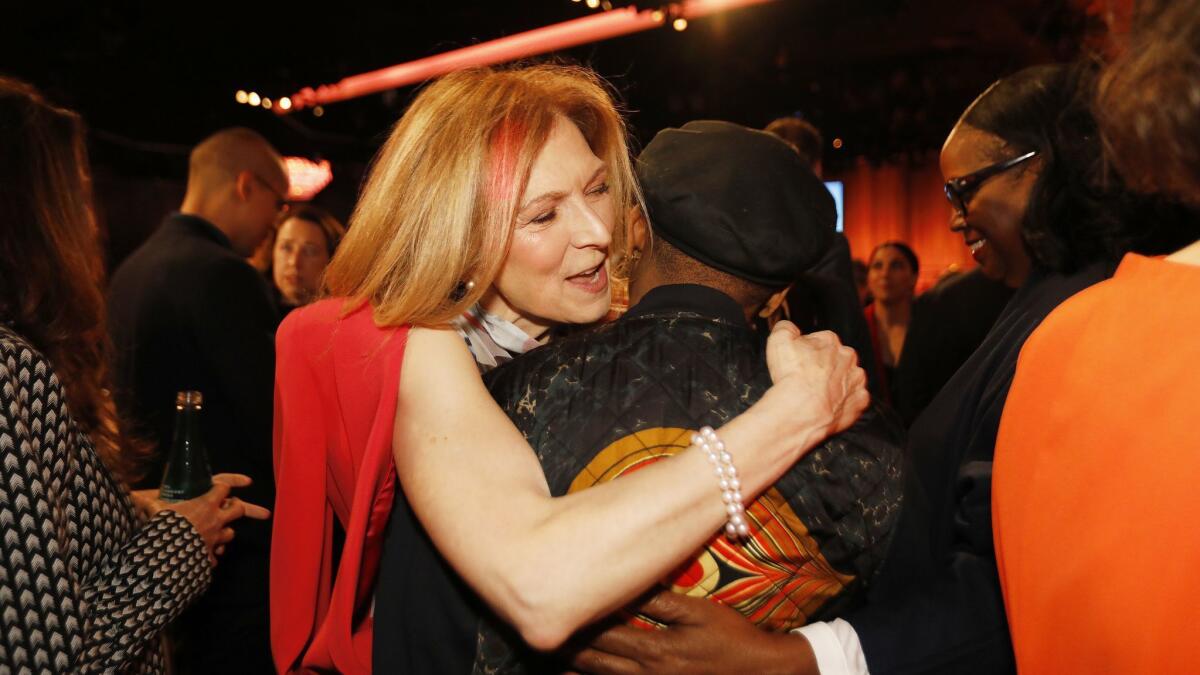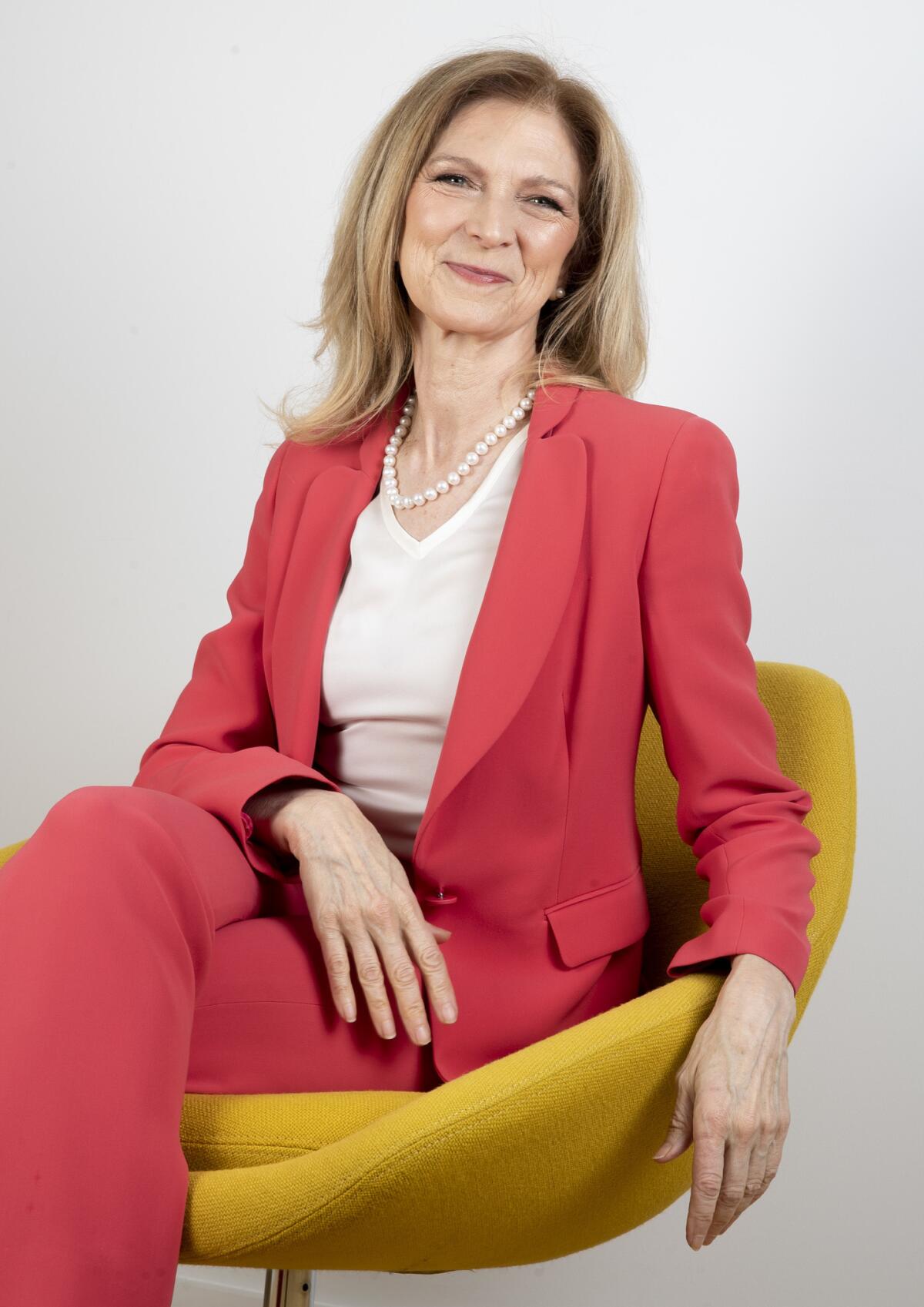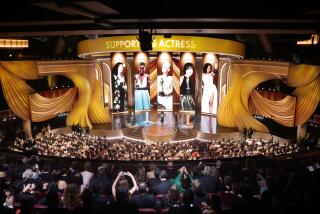Column: Academy CEO Dawn Hudson on 8 years of trying to modernize a 92-year-old boys’ club

Dawn Hudson has a trick for beating jet lag: She refuses to believe in it.
“I set my watch for the new time and go from there.”
That ability to put mind over matter has helped her navigate thus far as the first chief executive of the Academy of Motion Picture Arts and Sciences. Eight years of change, controversy, criticism and occasional chaos have turned a Hollywood fixture, with all the pertinent connotations of calcification, into a roiling center of conversations about inclusivity, sexual harassment, digital disruption and globalization.
And a near-constant newsmaker.
In the last two weeks, the academy has made two big announcements that perfectly encapsulate its tumultuous transformation: First, that the opening of the long-awaited academy museum has been pushed back, yet again, sometime after the 2020 Oscars. (Cue groans and pointed questions about whether it will ever open).
Second, that the new class of members is, for the first time, half female. Ten branches, including directing and screenwriting, invited more women than men this year, while the number of people of color has more than doubled in three years. (Cue applause and pointed observations that the overall membership remains predominantly male and white.)
It was exactly the sort of news-cycle two-step — “Moonlight” won. But only after a colossal announcement blunder. There will be a popular film category. Wait — no, there won’t. — that has defined the academy during Hudson’s tenure.
In Hollywood, the worst thing anyone can say about you is nothing at all, and that has not been a problem since Hudson came on board.
“Any institution that has a place in the world we live in is going to be praised and criticized on a minute-by-minute basis,” she says in a rare hour-plus sit-down at the academy’s headquarters in Beverly Hills. “You have to stay focused on what you think is important.”
What Hudson, her staff and the film academy’s board of governors consider important, she says, is an organization that reflects the modern world, including the sometimes heated debates over change.
“Everyone in this institution understands the legacy of the Oscar,” she says. “The academy grew up around a cozy club that was the center of the universe, and it was wonderful — if you were part of that club. We are still an exclusive club, we’re just not an exclusionary club.”
Hudson, 63, is a tall woman, with just a touch of her native Arkansas twang, and a ready laugh. She is publicly unflappable, more than occasionally polarizing and quantifiably relentless; the term “steel magnolia” has been used by more than one person to describe her over the years.
Though she began her career in the entertainment business as an actress, she made her name running Film Independent, where she helped expand the Spirit Awards into an awards season player. In 2011, she was a surprise hire for the newly created position of chief executive of the film academy, tasked with a mandate to drag the cloistered, glamorous yet mostly anonymous boys club into the 21st century.
Kicking and screaming if necessary.
Which were among the first sounds heard from certain quarters. Less than a year after she started, a few members (almost always off the record) began making their unhappiness known.
Unhappiness over certain personnel changes, over her desire to remodel the academy offices, her insistence on diversity, her refusal to follow time-honored protocols.
“There are conversations about change, and then there is the experience of change,” Hudson says now, repeating the diplomatic answer she has given over the years. “I was a new leader, in a new role, with a broader mandate. It was all new,” she says, then adds with a wry laugh. “And I was a woman.”
In fact, one of a very few when she began. In 2012, a Times investigation would reveal just how overwhelmingly white (94%) and male (77%) the film academy membership was, and its leadership was no different.
“There were five women on the board when I started,” Hudson says. “Now, there are 25. There were two people of color; now, there are 11 — 20%. The conversations are different when you have a more diverse board.”

Those protests flagged perhaps the biggest change the academy has seen in the last eight years — that it’s in the news at all.
Not that long ago, the academy made news almost exclusively during the very small window surrounding the Oscar telecast and then for three things — the choice of host, the nominees/winners and the ratings.
Now, it makes news all the time — for announcing, after decades of conversation, the building of a film museum. For answering #OscarsSoWhite by launching a membership initiative with the goal of doubling the number of women and people of color by 2020. For expelling Harvey Weinstein after allegations of sexual harassment came to light, for issuing a code of conduct following same, for then expelling Roman Polanski and Bill Cosby for breaking it. For internal grumbling and for at least one resignation over the notion of the academy “policing” the lives of its members.
The organization made news for scrambling to find funds for the above-mentioned museum and for annually pushing back the date of its opening. For adding, in four years, more than 4,000 new members to increase diversity. For announcing that four categories would be awarded off-camera and that a popular film Oscar would be added, and then walking back both those decisions after shouts of protest. For the ongoing conversation about the place streaming platforms occupy in the world of cinema. For asking Kevin Hart to apologize for old homophobic tweets before he could host the 2019 Oscars. For deciding to go without a host after Hart withdrew.
All accompanied and fueled by the deafening chatter of a million tweets, posts, columns and takes that swung from praise to accusations of too much/not enough change.
So what’s it like being in the eye of such a strange, one-damn-thing-after-another, live-from-the-red-carpet SigAlert?
Hudson takes it in stride: “The fact that the academy is seen as being so important to the cultural conversation is a big compliment.”
The rise of social media, she says, has made the job a more intense experience than she expected, but “it is a different experience running any institution, and we’re all learning as it changes so fast.”
Yes, she wishes the world would realize that the academy leadership does not control the entire industry — “We don’t choose who’s hired to direct or what films get made” — or even which movies academy members will choose to honor (hence the notion of a popular Oscar). But she is happy for any feedback, even the anger. Maybe especially the anger.
“The fact that people feel so strongly about the Oscars, that everyone wants to talk about the Oscars even if they don’t agree, is only positive proof how much they matter.”
Hudson’s enthusiasm is unfailing, admirable and infectious. She admits that when the 2018 Oscar telecast hit a new ratings low, there were “serious conversations” about what had to be done, but she sees the controversies as necessary conversations, and she is happy to point out that this year’s hostless Oscars saw a 12% jump in viewership, the first increase in five years.
The fact that the academy is seen as being so important to the cultural conversation is a big compliment.
— Dawn Hudson
When asked whether she has had a “best day,” she answers immediately: “The night we got the nominations this year, that was one of the all-time great moments. Those nominations were international and diverse, in all ways — I felt they represented this evolving academy. That was fun.”
The thrill of watching the museum come to fruition, even with the deadline setbacks, is also right up there.
“I remember the first vote, to do a year of explanation when everyone raised their hands,” Hudson says.
But when asked if, given all the bumps in the road, she’s ever had a day, or even a moment, when she thought, “You know what? Life is just too short for this insanity,” she laughs in sincere disbelief and says, “No.” She says she believes too strongly in the importance of the academy to have had a really bad day.
Yet there is no denying that some of the harshest criticism has been directed not at the board or the amorphous “academy,” but at her.
Early reports of members calling for the academy to buy out Hudson’s contract gave way to reports that she did not get along with then-academy President Cheryl Boone Isaacs, a major force behind the organization’s diversity initiative. Two years ago, Paramount Pictures Chairman Jim Gianopulos presented a report to academy board members that criticized Hudson’s oversight of the museum. (Shortly thereafter, the board voted to extend her contract three more years, through 2020.)
Last year, producer Bill Mechanic resigned from the board via a letter in which he excoriated the leadership for putting too much emphasis on diversity numbers and condemned the post-Weinstein code of conduct as outside the organization’s purview.
It has made for a steep learning curve, Hudson says, adding, but “I understood that this is not personal. I came in and I stood for something. For some people, I stood for change they didn’t want. It wasn’t really about me, it was just about the new directions for the academy, the new directions for our world, that are threatening to some people.”
As for the museum, she says she remembers going to a party for the 10th anniversary of Walt Disney Concert Hall and seeing, projected on the building’s smooth skin, all the headlines about how it was in trouble, how it would never be built.
Waiting on civic buildings is a bit of an L.A. hobby, but Hudson says she doesn’t need to talk with other museum directors for sympathy — “I just need to talk to anyone who’s had their kitchen remodeled. Look, no one has ever done this before, a film museum this big, this ambitious.
“It’s stunning. We want it to get it right.”
More to Read
The biggest entertainment stories
Get our big stories about Hollywood, film, television, music, arts, culture and more right in your inbox as soon as they publish.
You may occasionally receive promotional content from the Los Angeles Times.











